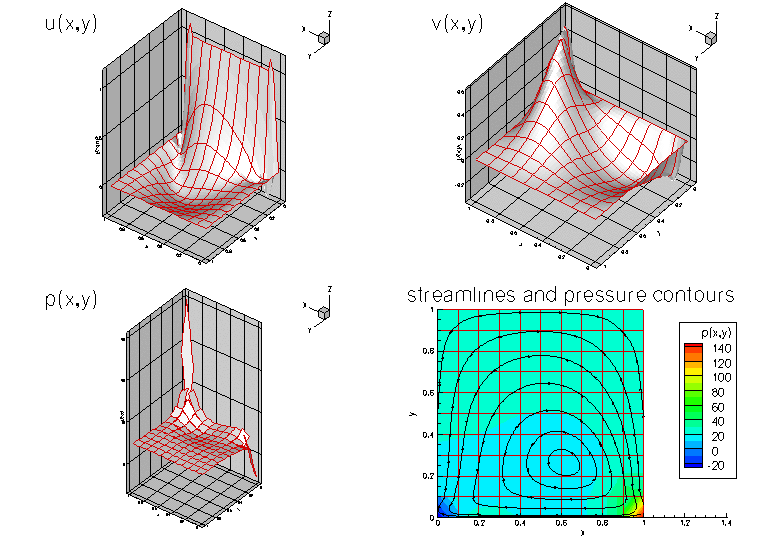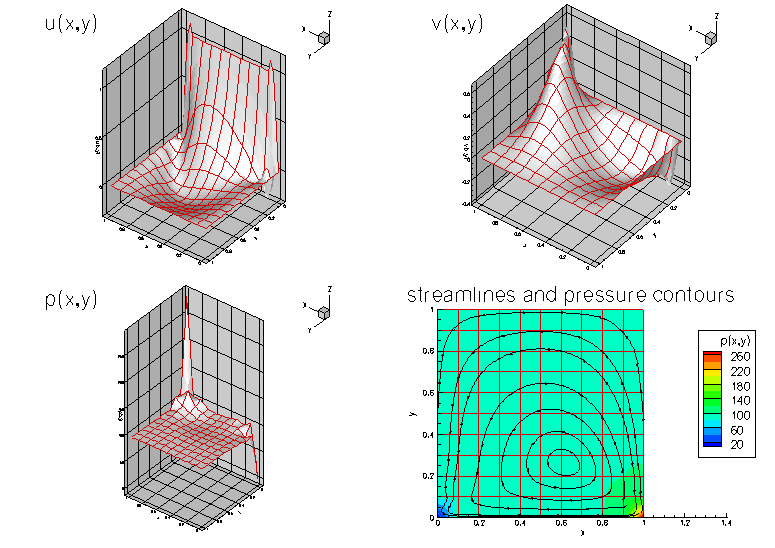This is our first Navier-Stokes example problem. We discuss the non-dimensionalisation of the equations and their implementation in oomph-lib, and demonstrate the solution of the 2D driven cavity problem.
The Navier-Stokes equations
In dimensional form the 2D [3D] Navier-Stokes equations (in cartesian coordinates ![$ x_i^*; \ i=1,2 [,3] $](form_0.png)
![\[
\rho\left(\frac{\partial u_i^*}{\partial t^*} +
u_j^*\frac{\partial u_i^*}{\partial x_j^*}\right)
=
- \frac{\partial p^*}{\partial x_i^*} +
B_i^*(x_j^*,t^*) + \rho \, G^*_i +
\frac{\partial }{\partial x_j^*} \left[ \mu\left(
\frac{\partial u_i^*}{\partial x_j^*} +
\frac{\partial u_j^*}{\partial x_i^*} \right) \right],
\]](form_1.png)
and the continuity equation
![\[
\frac{\partial u_i^*}{\partial x_i^*} = Q^*,
\]](form_2.png)
where we have used index notation and the summation convention.
Here, the velocity components are denoted by 





We non-dimensionalise the equations, using problem-specific reference quantities for the velocity, 



![\[
u_i^* = {\cal U} \, u_i, \qquad
x_i^* = {\cal L}\, x_i, \qquad
t^* = {\cal T}\, t, \qquad
G_i^* = g \, G_i,
\]](form_13.png)
![\[
p^* = \frac{\mu_{ref} {\cal U}}{{\cal L}} \, p, \qquad
B_i^* = \frac{{\cal U}\mu_{ref}}{{\cal L}^2} \, B_i, \qquad
Q^* = \frac{{\cal U}}{{\cal L}}\, Q, \qquad
\]](form_14.png)
where we note that the pressure and the variable body force have been non-dimensionalised on the viscous scale. 



The non-dimensional form of the Navier-Stokes equations is then given by
![\[
R_\rho Re \left( St \frac{\partial u_i}{\partial t} +
u_j \frac{\partial u_i}{\partial x_j} \right) =
- \frac{\partial p}{\partial x_i} + B_i(x_j,t) +
R_\rho \frac{Re}{Fr} G_i +
\frac{\partial }{\partial x_j} \left[ R_\mu \left(
\frac{\partial u_i}{\partial x_j} +
\frac{\partial u_j}{\partial x_i} \right) \right],
\]](form_19.png)
and
![\[
\frac{\partial u_i}{\partial x_i} = Q,
\]](form_20.png)
where the dimensionless parameters
![\[
Re = \frac{{\cal U}{\cal L}\rho_{ref}}{\mu_{ref}}, \qquad
St = \frac{{\cal L}}{{\cal U}{\cal T}}, \qquad
Fr = \frac{{\cal U}^2}{g{\cal L}},
\]](form_21.png)
are the Reynolds number, Strouhal number and Froude number respectively. 


The above equations are typically augmented by Dirichlet boundary conditions for (some of) the velocity components. On boundaries where no velocity boundary conditions are applied, the flow satisfies the "traction free" natural boundary condition 
If the velocity is prescribed along the entire domain boundary, the fluid pressure 
Implementation
The elements
oomph-lib provides two LBB-stable isoparametric Navier-Stokes elements that are based on the QElement<DIM,3> family of geometric finite elements. They are nine-node quadrilateral (for DIM=2), and 27-node brick (for DIM=3) elements in which the mapping between local and global (Eulerian) coordinates is given by
![\[
x_i = \sum_{j=1}^{N^{(E)}} X^{(E)}_{ij} \, \psi_j, \qquad
i=1,2\quad [\mbox{and }3].
\]](form_27.png)
Here 



Node in the element, and the 
QElement<DIM,3> class.
In both elements the velocity components 


![\[
u_i = \sum_{j=1}^{N^{(E)}} U^{(E)}_{ij} \, \psi_j, \qquad
i=1,2\quad [\mbox{and }3],
\]](form_36.png)
where 


Node in the element. Nodal values of the velocity components are accessible via the access function
which returns the i-th velocity component stored at the element's j-th Node.
The two elements differ in the way in which the pressure is represented:
Crouzeix-Raviart elements
In oomph-lib's QCrouzeixRaviartElements the pressure is represented by,
![\[
p = P_0^{(E)} + P_1^{(E)} \, s_1 + P_2^{(E)} \, s_2
\quad \left[+ P_3^{(E)} \, s_3\right],
\]](form_38.png)
where the ![$ s_i \in [-1,1]$](form_39.png)
The pressure degrees of freedom are local to the element and are stored in the element's internal Data. They are accessible via the member function
which returns the value of the j-th pressure degree of freedom in this element.
Each Node in a 2D [3D] Crouzeix-Raviart element stores 2 [3] nodal values, representing the two [three] velocity components at that Node.
Taylor-Hood elements
In oomph-lib's QTaylorHoodElements the pressure is represented by a globally-continuous, piecewise bi-[tri-]linear interpolation between the pressure values 

![\[
p = \sum_{j=1}^{N_p^{(E)}} P_j^{(E)} \, \psi_j^{(p)},
\]](form_42.png)
where the 
The first 2 [3] values of each Node in a 2D [3D] Taylor-Hood element store the two [three] velocity components at that Node. The corner [vertex] nodes store an additional value which represents the pressure at that Node. The access function
returns the nodal pressure value at the element's j-th corner [vertex] Node.
In sufficiently fine meshes, Taylor-Hood elements generate a much smaller number of pressure degrees of freedom than the corresponding Crouzeix-Raviart elements. However, Taylor-Hood elements do not conserve mass locally.
Non-dimensional parameters and their default values
The Reynolds number, Strouhal number, inverse-Froude number, density ratio and viscosity ratio are assumed to be constant within each element. Their values are accessed via pointers which are accessible via the member functions re_pt() for 
re_st_pt() for 
re_invfr_pt() for 
density_ratio_pt() for 
viscosity_ratio_pt() for 
By default the pointers point to default values (implemented as static member data in the NavierStokesEquations class), therefore they only need to be over-written if the default values are not appropriate. The default values are:
- Default Reynolds number:
![\[
Re = 0 \mbox{\ \ \ \ (Stokes flow)}
\]](form_49.png)
- Default Womersley number (product of Reynolds and Strouhal number):
![\[
Re St = 0 \mbox{\ \ \ \ (steady flow)}
\]](form_50.png)
- Default product of Reynolds and inverse Froude number (a measure of gravity on the viscous scale)
![\[
Re/Fr = 0 \mbox{\ \ \ \ (no gravity)}
\]](form_51.png)
- Default viscosity ratio:
![\[
R_\mu = 1 \mbox{\ \ \ \ (viscosity = viscosity used in the definition
of $Re$)}
\]](form_52.png)
- Default density ratio:
![\[
R_\rho = 1 \mbox{\ \ \ \ (density = density used in the definition
of $Re$)}
\]](form_53.png)
We use the same approach for the specification of the body force vector 
g_pt (), the variable body force 
body_force_fct_pt(), and the volumetric source function 
source_fct_pt(time,x). By default the (function) pointers are set such that
- Default gravity vector:
![\[
G_i = 0 \mbox{\ \ \ \ (no gravity)}
\]](form_57.png)
- Default body force function:
![\[
B_i(x_j,t) = 0 \mbox{\ \ \ \ (no body force)}
\]](form_58.png)
- Default volumetric source function
![\[
Q(x_j,t) = 0 \mbox{\ \ \ \ (flow is divergence free)}
\]](form_59.png)
The example problem
We will illustrate the solution of the steady 2D Navier-Stokes equations using the well-known example of the driven cavity.
|
Results
Crouzeix-Raviart elements
The figure below shows "carpet plots" of the velocity and pressure fields as well as a contour plot of the pressure distribution with superimposed streamlines. The velocity vanishes along the entire domain boundary, apart from the bottom boundary 




Taylor-Hood elements
The next figure shows the corresponding results obtained from a computation with QTaylorHoodElements. The pressure plot illustrates how the interpolation between the corner nodes creates a globally continuous representation of the pressure.

Note that in both simulations, the flow field is clearly under-resolved near the ends of the "lid". In another example we will demonstrate the use of spatial adaptivity to obtain much better solutions for this problem.
Global parameters and functions
The Reynolds number is the only non-dimensional parameter needed in this problem. As usual, we define it in a namespace:
The driver code
We start by creating a DocInfo object to store the output directory and the label for the output files.
We build the problem using QCrouzeixRaviartElements, solve using the Problem::newton_solve() function, and document the result before incrementing the label for the output files.
Finally, we repeat the process with QTaylorHoodElements.
The problem class
The Problem class for our steady Navier-Stokes problem is very similar to those used for the steady scalar problems (Poisson and advection-diffusion) that we considered in previous examples. We provide a helper function fix_pressure(...) which pins a pressure value in a specified element and assigns a specific value.
No actions are performed after the solution is found, since the solution is documented in main. However, before solving, the boundary conditions must be set.
Finally, we provide an access function to the specific mesh and define the post-processing function doc_solution(...).
The problem constructor
Since this is a steady problem, the constructor is quite simple. We begin by building the mesh and pin the velocities on the boundaries.
Next we pass a pointer to the Reynolds number (stored in Global_Physical_Variables::Re) to all elements.
Since Dirichlet conditions are applied to both velocity components on all boundaries, the pressure is only determined up to an arbitrary constant. We use the fix_pressure(...) function to pin the first pressure value in the first element and set its value to zero.
Finally, the equation numbering scheme is set up, using the function assign_eqn_numbers().
Post-processing
As expected, this member function documents the computed solution.
Comments and Exercises
The stress-divergence form
As discussed in the introduction, by default oomph-lib's Navier-Stokes elements use the stress-divergence form of the momentum equations,
![\[
R_\rho Re \left( St \frac{\partial u_i}{\partial t} +
u_j \frac{\partial u_i}{\partial x_j} \right) =
- \frac{\partial p}{\partial x_i} + B_i(x_j) +
R_\rho \frac{Re}{Fr} G_i +
\frac{\partial }{\partial x_j} \left[ R_\mu \left(
\frac{\partial u_i}{\partial x_j} +
\frac{\partial u_j}{\partial x_i} \right) \right],
\]](form_70.png)
as this form is required in problems with free surfaces or problems in which traction boundary conditions are applied.
If the flow is divergence free ( 
![\[
R_\rho Re \left( St \frac{\partial u_i}{\partial t} +
u_j \frac{\partial u_i}{\partial x_j} \right) =
- \frac{\partial p}{\partial x_i} + B_i(x_j) +
R_\rho \frac{Re}{Fr} G_i + R_\mu
\frac{\partial^2 u_i }{\partial x_j^2},
\]](form_72.png)
assuming that the viscosity ratio 
This simpler form of the equations can be used to solve problems that do not incorporate traction boundaries or free surfaces. We illustrate the use of these equations in another example.
Exercises
- Compare the pressure distributions obtained with Taylor-Hood elements to that computed with Crouzeix-Raviart elements. Why do they differ? [Hint: Consider how the pressure is represented in the two elements.]
- Confirm that the velocities stored at boundary nodes must be pinned. Investigate what happens if you do not apply any velocity boundary conditions [Hint: You should still be able to
compute a solution – what does this solution represent?] - Investigate what happens when no pressure value is fixed.
Source files for this tutorial
- The source files for this tutorial are located in the directory:
demo_drivers/navier_stokes/driven_cavity/ - The driver code is:
demo_drivers/navier_stokes/driven_cavity/driven_cavity.cc
PDF file
A pdf version of this document is available.
![\[
Re\phantom{i}u_j\frac{\partial u_i}{\partial x_j} =
- \frac{\partial p}{\partial x_i} +
\frac{\partial }{\partial x_j} \left(
\frac{\partial u_i}{\partial x_j} +
\frac{\partial u_j}{\partial x_i} \right),
\ \ \ \ \ \ \ \ \ \ (1)
\]](form_60.png)
![\[
\frac{\partial u_i}{\partial x_i} = 0,
\]](form_61.png)
![$ D = \{x_i \in [0,1]; i=1,2 \} $](form_62.png)
![\[
\left. \mathbf{u}\right|_{\partial D}=(0,0),
\ \ \ \ \ \ \ \ \ \ (2)
\]](form_63.png)
![\[
\left. \mathbf{u}\right|_{\partial D}=(1,0),
\ \ \ \ \ \ \ \ \ \ (3)
\]](form_64.png)
